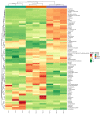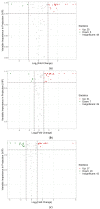Metabolomic Study of Flavonoids in Camellia drupifera under Aluminum Stress by UPLC-MS/MS
- PMID: 37050058
- PMCID: PMC10097190
- DOI: 10.3390/plants12071432
Metabolomic Study of Flavonoids in Camellia drupifera under Aluminum Stress by UPLC-MS/MS
Abstract
Aluminum (Al) affects the yield of forest trees in acidic soils. The oil tea plant (Camellia drupifera Lour.) has high Al tolerance, with abundant phenolic compounds in its leaves, especially flavonoid compounds. The role of these flavonoids in the Al resistance of oil tea plants is unclear. In this metabolomic study of C. drupifera under Al stress, ultra-pressure liquid chromatography coupled with tandem mass spectrometry (UPLC-MS/MS) was utilized to identify metabolites, while principal component analysis, cluster analysis, and orthogonal partial least squares discriminant analysis were applied to analyze the data on the flavonoid metabolites. The leaf morphology of C. drupifera revealed significant damage by excess aluminum ions under each treatment compared with the control group. Under Al stress at 2 mmol/L (GZ2) and 4 mmol/L (GZ4), the total flavonoid content in C. drupifera leaves reached 24.37 and 35.64 mg/g, respectively, which are significantly higher than the levels measured in the control group (CK) (p < 0.01). In addition, we identified 25 upregulated and 5 downregulated metabolites in the GZ2 vs. CK comparison and 31 upregulated and 7 downregulated flavonoid metabolites in GZ4 vs. CK. The results demonstrate that different levels of Al stress had a significant influence on the metabolite profile of C. drupifera. It was found that the abundance of the 24 differential flavonoid metabolites was gradually elevated with increasing concentrations of Al stress, including catechin, epicatechin, naringenin-7-glucoside, astilbin, taxifolin, miquelianin, quercitrin, and quercimeritrin. Moreover, the most significant increase in antioxidant activity (about 30%) was observed in C. drupifera precultured in leaf extracts containing 7.5 and 15 μg/mL of active flavonoids. The qRT-PCR results showed that the expression levels of key genes involved in the synthesis of flavonoids were consistent with the accumulation trends of flavonoids under different concentrations of Al. Therefore, our results demonstrate the key role of flavonoid compounds in the oil tea plant C. drupifera in response to Al stress, which suggests that flavonoid metabolites in C. drupifera, as well as other aluminum-tolerant plants, may help with detoxifying aluminum.
Keywords: Camellia drupifera; UPLC-MS/MS; aluminum stress; flavonoid metabolites.
Conflict of interest statement
The authors declare no conflict of interest.
Figures












Similar articles
-
Physiological and Proteomic Changes in Camellia semiserrata in Response to Aluminum Stress.Genes (Basel). 2023 Dec 29;15(1):55. doi: 10.3390/genes15010055. Genes (Basel). 2023. PMID: 38254944 Free PMC article.
-
Metabolomic profiles and health-promoting functions of Camellia drupifera mature-seeds were revealed relate to their geographical origins using comparative metabolomic analysis and network pharmacology approach.Food Chem. 2023 Nov 15;426:136619. doi: 10.1016/j.foodchem.2023.136619. Epub 2023 Jun 13. Food Chem. 2023. PMID: 37329789
-
Analysis of Flavonoid Metabolites in Buckwheat Leaves Using UPLC-ESI-MS/MS.Molecules. 2019 Apr 3;24(7):1310. doi: 10.3390/molecules24071310. Molecules. 2019. PMID: 30987158 Free PMC article.
-
Metabolite Analysis of Camellia oleifera Fruit Pericarp Using UPLC-MS/MS: A Comparative Study of Three Oil Tea Varieties.Int J Mol Sci. 2024 Nov 7;25(22):11973. doi: 10.3390/ijms252211973. Int J Mol Sci. 2024. PMID: 39596042 Free PMC article.
-
Metabolomics Study of Flavonoids of Taxilluschinensis on Different Hosts Using UPLC-ESI-MS/MS.Molecules. 2021 Dec 19;26(24):7681. doi: 10.3390/molecules26247681. Molecules. 2021. PMID: 34946763 Free PMC article.
Cited by
-
Physiological and Proteomic Changes in Camellia semiserrata in Response to Aluminum Stress.Genes (Basel). 2023 Dec 29;15(1):55. doi: 10.3390/genes15010055. Genes (Basel). 2023. PMID: 38254944 Free PMC article.
-
Unraveling the Bioactive Potential of Camellia japonica Edible Flowers: Profiling Antioxidant Substances and In Vitro Bioactivity Assessment.Pharmaceuticals (Basel). 2024 Jul 15;17(7):946. doi: 10.3390/ph17070946. Pharmaceuticals (Basel). 2024. PMID: 39065796 Free PMC article.
-
Commonalities and Specificities in Wheat (Triticum aestivum L.) Responses to Aluminum Toxicity and Low Phosphorus Revealed by Transcriptomics and Targeted Metabolomics.Int J Mol Sci. 2024 Aug 27;25(17):9273. doi: 10.3390/ijms25179273. Int J Mol Sci. 2024. PMID: 39273221 Free PMC article.
References
-
- Zhuang R.L. Chinese Camellia. 2nd ed. Forestry Publishing House; Beijing, China: 2008. pp. 11–89.
-
- Li Y., Liao B., Wang Y., Luo H., Wang S., Li C., Song W., Zhang K., Yang B., Lu S., et al. Transcriptome and metabolome analyses provide insights into the relevance of pericarp thickness variations in Camellia drupifera and Camellia oleifera. Front. Plant Sci. 2022;13:1016475. doi: 10.3389/fpls.2022.1016475. - DOI - PMC - PubMed
-
- Qin S., Rong J., Zhang W., Chen J. Cultivation history of Camellia oleifera and genetic resources in the Yangtze River Basin. Biodivers. Sci. 2018;26:384–395. doi: 10.17520/biods.2017254. - DOI
-
- Yao X.H. Oil-Tea Camellia Cultivars in China. 1st ed. Volume 11. Forestry Publishing House; Beijing, China: 2016. pp. 32–33.
Grants and funding
LinkOut - more resources
Full Text Sources
Research Materials

